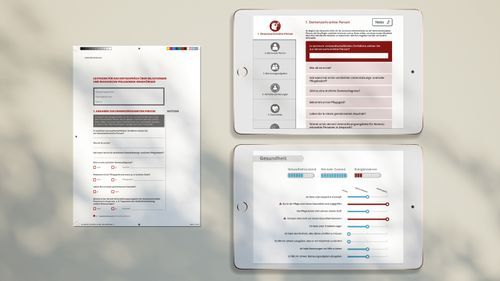This project resulted from a cooperation of the University of Applied Sciences St. Pölten with the NGO Volkshilfe. It involved the design and development of an interview guide to support social workers from the organisation in conducting professional conversations with people who take care of a family member with dementia. These interviews are carried out to discover the relatives' physical and mental stress. At the end of an interview, the social worker should hand over a visualisation of the results which highlight the key insights into their situation. Together with a group of wonderful fellow students, I entered the project as part of my project semester at the university. Our task was to digitise the interview guide and to redesign the visualisations of the evaluation. The result of our work should be an application which primarily runs on tablets and provides the ability to export the evaluation as a PDF.

Implementation
The guide consists of nine categories containing a multitude of questions. Thus, the ability to navigate and fill out the questionnaire efficiently was a main focus of the project. Our goal was to create an application which does not get in the way of the social worker while conducting the dialogue with the relative. We, therefore, carried out two usability evaluations to discover stumbling blocks and inconveniences in our application. The redesign of the visualisation was exciting too. We relied on metaphors, recurring patterns and colours to improve the comprehensibility of the graphics.
My team decided to implement the project as a Progressive Web App (PWA) due to the future-proof nature of the web. For this purpose, we created a Single Page Application using the frontend framework Vue.js. This was a perfect fit considering the high degree of interactivity we had to implement. As the application should work in remote areas without an internet connection, we implemented offline support once the PWA is installed on a device. The project partner also requested that the application works without a backend server due to the effort necessary to protect the sensitive data. This made exporting the visualisations as a PDF challenging. We, therefore, searched for JavaScript libraries enabled a client-side generation of PDFs. However, we did not find a good solution which we wanted to use (bundle size too big, text inserted as image, necessary reimplementation of all visualisations, etc.). Instead, we entirely relied on the baked-in print functionality of browsers. This aspect of the project was extremely troublesome but rewarding nonetheless.
I am proud of the fact that the questionnaire is generated using a human-readable YAML file. This enables the project partner to adapt the application to their needs and contributes to the project's sustainability.
Who benefits from the project
I enjoyed working on this project because it was especially meaningful to me. I know the problems a family faces which takes care of a person with dementia. Therefore, I am grateful that I could contribute to helping others in this difficult situation.
My team's work primarily supports social workers. Previously, they had to transfer the data from the analogue questionnaire to an Excel sheet. This tedious could be prevented by our application so that social workers may focus on the relevant aspects of their work — helping people. Moreover, the relatives benefit from the application as they can receive their beautifully visualised evaluation immediately. Before, they had to wait for the social worker to return to his office and create the Excel sheet. This immediacy improves the impact of such an interview on the relatives as we were told.
What I learned
The project was finished on time and with great success. We even won the Sustainable Development Award 2020 in the category "sustainability and social impact".
This was only possible due to the great teamwork I experienced in this project. I am grateful for working with my extremely talented and ambitious colleagues. This experience gives me the feeling that everything can be accomplished with the right people on your side.
The second thing this project taught me was how important user-centred design is. I quickly realised that I cannot predict how people use the things I develop. However, I also understood that this is fine as long as I work together with them and discover my wrong assumptions early.